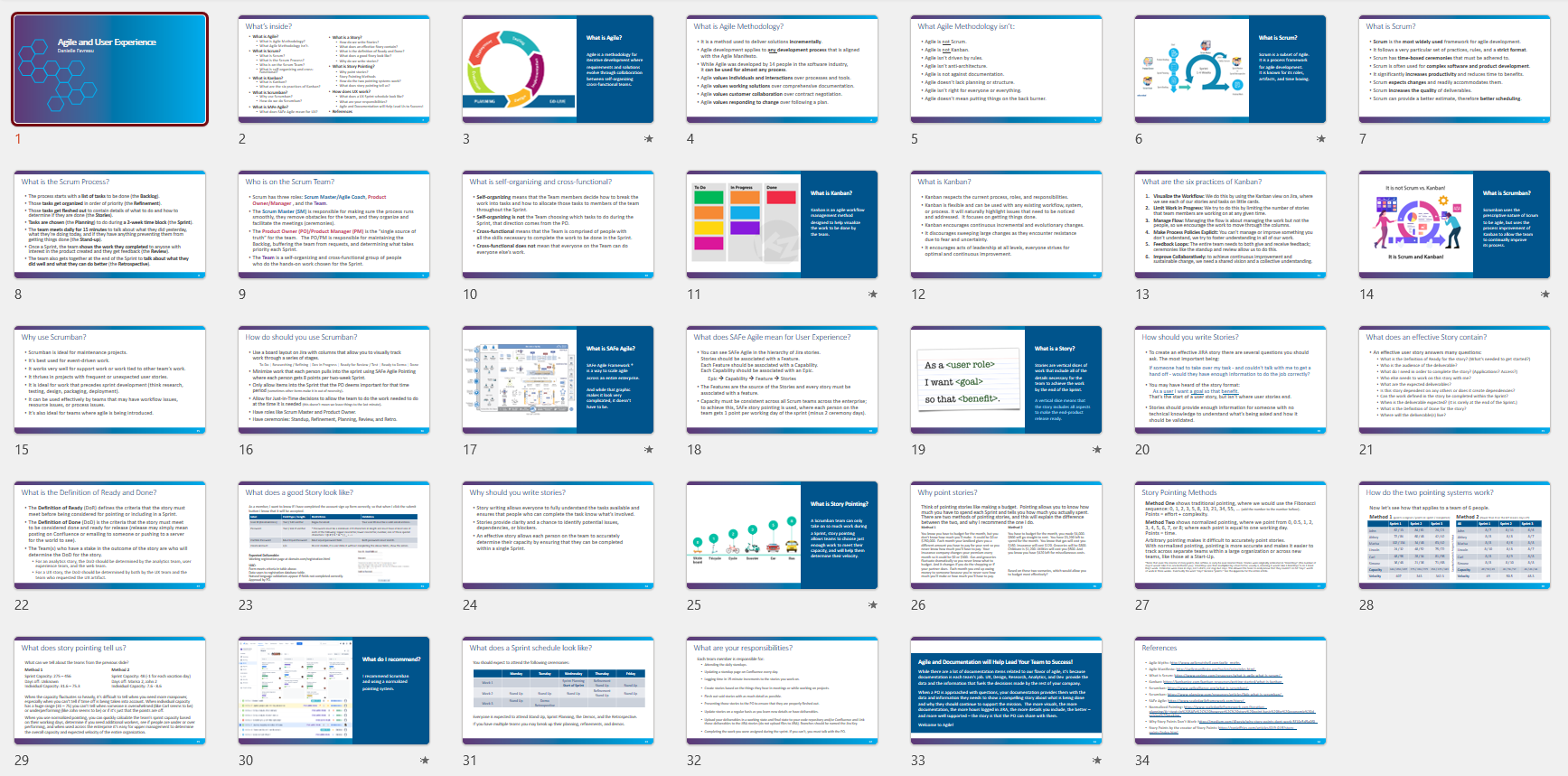Introduction
Agile methodologies, including frameworks like Scrum, Kanban, and Scrumban, offer organizations a robust approach to iterative development, enabling teams to deliver high-quality results more efficiently. This case study explores the integration of Agile practices into large, small, and startup organizations, with a focus on their implications for User Experience (UX) teams. Click the image below to download the PDF of the presentation.
Agile and Its Core Concepts
Agile is a methodology focused on iterative development, where both the requirements and solutions evolve through continuous collaboration between self-organizing, cross-functional teams. Agile prioritizes individuals and interactions over processes, working solutions over comprehensive documentation, customer collaboration over contract negotiation, and responding to change over following a rigid plan.
However, it’s essential to note that Agile is not synonymous with specific frameworks like Scrum or Kanban. Instead, it’s a mindset that can be applied across different organizational settings to improve productivity, flexibility, and quality.
Key Agile Frameworks: Scrum, Kanban, and Scrumban
- Scrum
Scrum is the most widely adopted framework within Agile, used primarily for complex software and product development. It operates in short, time-boxed sprints, typically lasting two weeks, where teams plan, develop, review, and reflect on their progress. Scrum promotes productivity, quality, and adaptability, allowing teams to embrace change and accommodate shifting project needs.Scrum roles include:- Scrum Master/Agile Coach: Ensures the process runs smoothly, removes obstacles, and facilitates Scrum ceremonies.
- Product Owner/Manager: Maintains the backlog, prioritizes tasks, and is the “single source of truth” for the team.
- Team: A cross-functional, self-organizing group that executes tasks within each sprint.
- Kanban
Kanban is a flexible method that visualizes work and emphasizes continuous flow. Unlike Scrum’s strict structure, Kanban is adaptable to existing workflows and can be seamlessly integrated into any process. Its six core practices—visualizing the workflow, limiting work in progress, managing flow, making process policies explicit, creating feedback loops, and improving collaboratively—help teams manage tasks efficiently. - Scrumban
Scrumban combines Scrum’s structured approach with Kanban’s continuous improvement model. It’s ideal for teams dealing with maintenance tasks, event-driven work, or support functions. Scrumban also accommodates unexpected user stories and can be especially helpful for startups or organizations in transition to Agile.
Scaling Agile: SAFe Agile
For larger enterprises or organizations with multiple Agile teams, the SAFe (Scaled Agile Framework) approach offers a way to scale Agile across an entire organization. SAFe introduces the concept of hierarchical story structures, where Epics are broken down into Capabilities, Features, and Stories. This scalability ensures consistent capacity and prioritization across all teams, improving efficiency and aligning work to business objectives.
User Experience and Agile
In Agile, User Experience (UX) teams must integrate seamlessly with the development process. The UX team contributes to every aspect of the sprint cycle, from writing stories and defining requirements to testing and validation. The following practices help align UX with Agile:
- Writing Effective Stories: UX teams collaborate with product owners and developers to write clear, detailed user stories. These stories should provide enough context for someone to take over the task without additional clarification. They also include acceptance criteria that define when a story is “done.”
- Story Pointing: Story pointing is a method of estimating the effort or complexity involved in a task. By assigning story points, teams can balance their workload and determine their capacity for each sprint.
- Sprint Schedule and Responsibilities: UX teams should expect to participate in key ceremonies such as Sprint Planning, Daily Stand-ups, Sprint Reviews, and Retrospectives. During these ceremonies, teams reflect on their progress, adjust workflows, and improve collaboration for future sprints.
Agile Implementation in Large, Small, and Startup Organizations
- Large Organizations:
In large organizations, implementing Agile through frameworks like Scrum or SAFe can significantly improve collaboration and productivity across departments. However, scaling Agile requires careful planning and coordination, especially when multiple teams are involved. By adopting a consistent approach to story pointing, defining clear responsibilities, and using tools like Jira to track progress, large organizations can create a streamlined development process that enhances efficiency. - Small Organizations:
Small teams may find Scrum’s strict ceremonies and roles too burdensome, and Kanban offers a more flexible alternative. By visualizing the workflow and limiting work in progress, small teams can improve task completion without the overhead of rigid processes. The adaptability of Kanban ensures that small teams can remain responsive to changing needs without sacrificing quality. - Startups:
For startups, the flexibility of Scrumban is highly advantageous. Scrumban allows teams to evolve their processes and workflows over time while maintaining the structure and discipline of Scrum. This approach is particularly useful for startups with limited resources or those in early stages of adopting Agile practices.
The Value of Agile for UX Teams
Agile methodologies offer a foundation for continuous improvement and iterative development. By adopting frameworks like Scrum, Kanban, and Scrumban, organizations of all sizes can foster a culture of collaboration, flexibility, and quality delivery. For UX teams, Agile provides an opportunity to integrate user-centered design practices into every stage of product development, ensuring that products meet user needs while adapting to changing market demands.
Through clear story writing, effective collaboration with development teams, and participation in Agile ceremonies, UX professionals can contribute to the success of Agile projects and deliver outstanding user experiences in every sprint.
Skills
- Agile Leadership
- SAFe
- Scrum
- Content Writing
- Design
- Graphic Design
- Photoshop
- Illustrator
- eLearning
- Presentation
- PowerPoint
- Product
- Product Management

